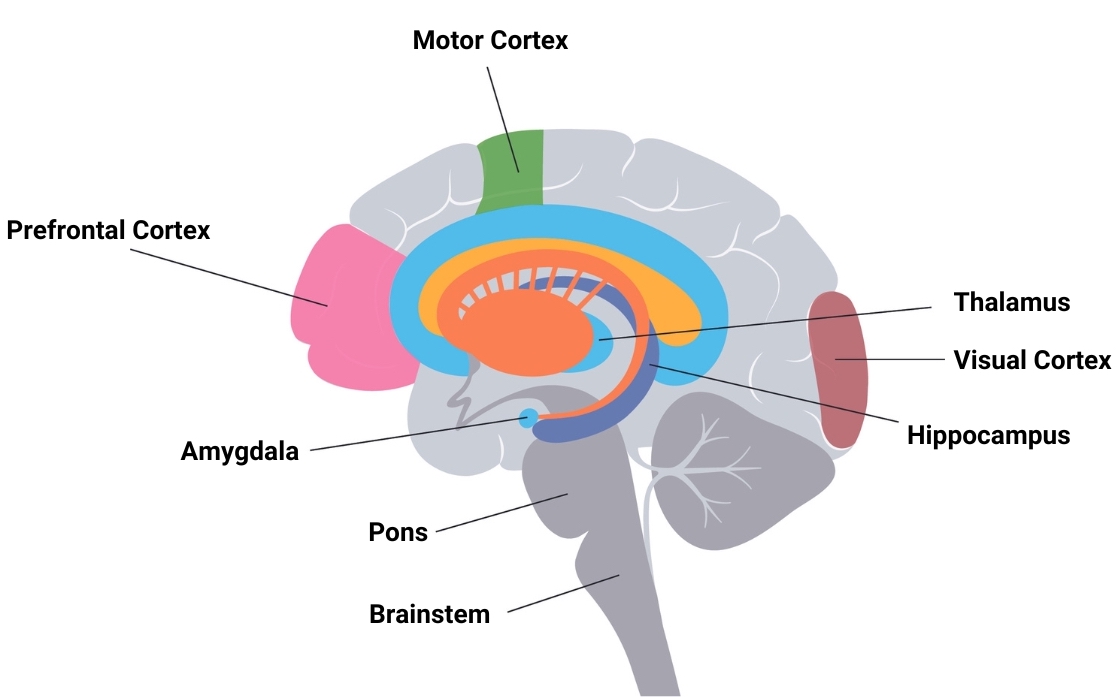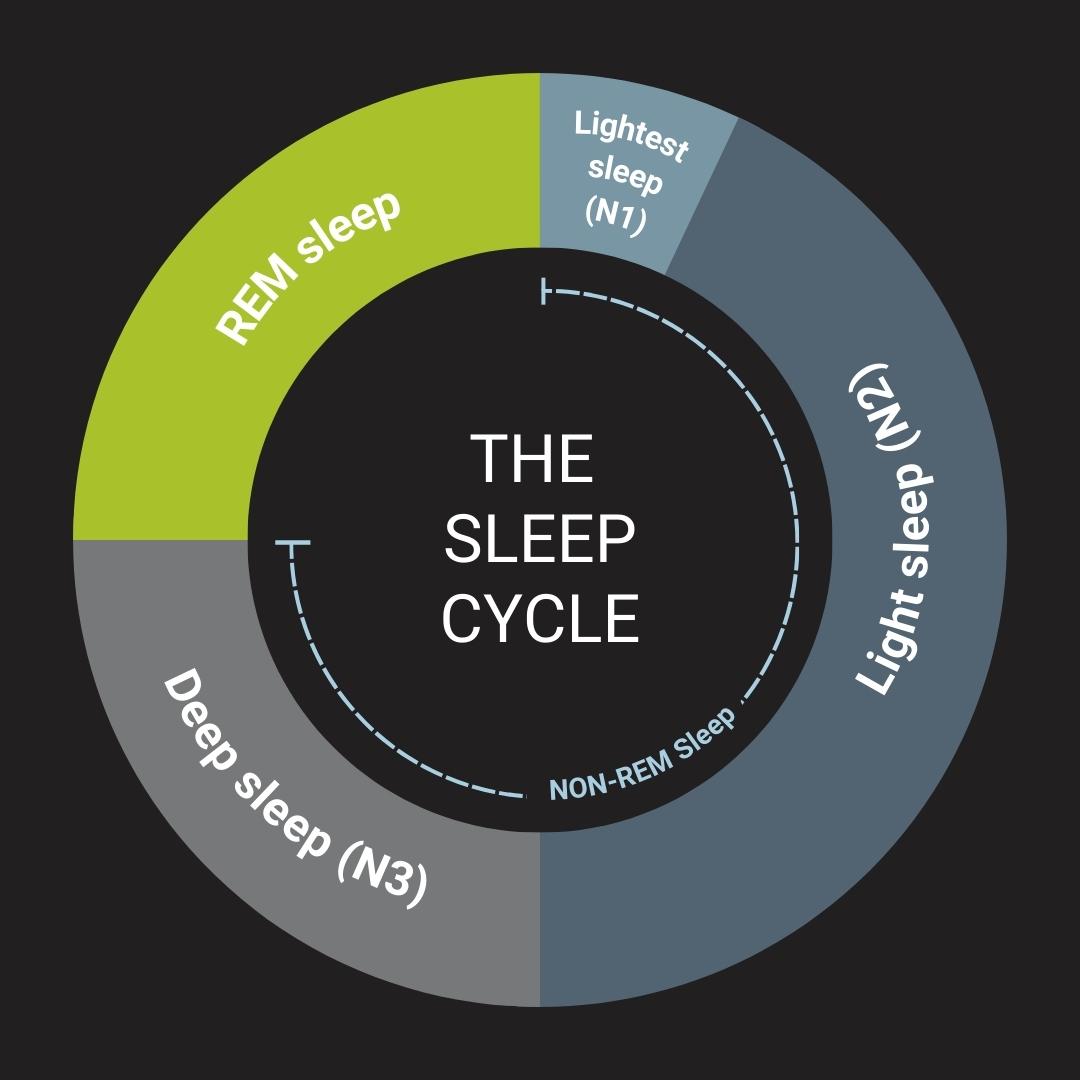Have you ever wondered what happens to your mind and body while you’re fast asleep?
Among sleep phases, REM stands out. It’s a sleep phase that is marked by closed-eyelid rapid eye movements and vivid dreams and has a major impact on your memory, mental focus, and mood.
Join us as we explore the secrets behind one of the most intriguing parts of your night.
- What is REM sleep?
- Where in the brain does it occur?
- Why is it important?
- Is REM sleep the same as deep sleep?
- How much REM do you need?
- What happens if you don’t get enough?
- How to get more REM sleep
- References
What is REM sleep?
Rapid eye movement (REM) sleep is a stage of sleep associated with dreaming and memory consolidation. It was first discovered in the 1950s, when scientists studying sleeping infants noticed that there were distinct times during the night when their eyes moved rapidly from side to side.
Here’s a breakdown of what happens to your body during REM:
- Eyes swiftly move back and forth behind closed eyelids.
- Heart rate and blood pressure rise nearly as high as when you’re awake.
- Breathing becomes faster and irregular.
- Your brain consumes more oxygen and its activity increases significantly
- Facial and limb twitching might occur, while other muscles experience temporary paralysis, preventing you from acting out your dreams.
REM is also often referred to as “Paradoxical Sleep” because it involves seemingly conflicting conditions of an active mind and a sleeping body.

Where in the brain does it occur?
During REM sleep, several parts of the brain are active and engaged in various functions 1. Some of the key parts of the brain that are active during this time include:
- Brainstem and Pons: The brainstem, specifically the pons, is a crucial area for regulating REM sleep. The pons helps regulate aspects of REM sleep, such as suppressing voluntary muscle movement (also known as muscle atonia) which stops you from moving while you’re dreaming.
- Amygdala: The amygdala, an almond-shaped structure involved in processing emotions, memories, and responses to fear, remains active during REM sleep.
- Hippocampus: The hippocampus is involved in memory consolidation, and its activity during REM sleep suggests a role in processing and storing memories, especially those with an emotional or spatial component.
- Thalamus: The thalamus is responsible for relaying sensory information to various parts of the brain, and it remains active during REM sleep. This could be related to the generation of dream imagery based on various sensory inputs.
- Visual and Motor Cortex: Despite the muscle atonia that prevents physical movement, the motor cortex still shows some activity during REM sleep (such as the rapid eye movements and minor twitching in the limbs).
- Prefrontal Cortex: The prefrontal cortex, responsible for executive functions like decision-making, planning, and self-control, shows reduced activity during REM sleep. This reduction in activity might explain the sometimes illogical or disjointed nature of dreams during this stage. The prefrontal cortex also regulates the amygdala and if you are sleep deprived, it ceases to ‘communicate’ with amygdala which can result in an unstable emotional state when you are awake.

Why is it important?
REM sleep plays a crucial role in your overall well-being as it’s associated with improved learning, memories, creativity, and emotional resilience.
The majority of your dreams take place during REM sleep. While REM is not the only stage in which dreams occur, the ones you experience in this stage are usually more vivid than their non-REM counterparts and studies show that these intense dreams are important for the processing of emotional memories (such as fear) 2.
During REM sleep, your brain processes new information and motor skills from the day, committing some to memory, maintaining others, and deciding which ones to delete.
Researchers hypothesize REM sleep promotes brain development, since newborns spend most of their sleep time in REM. Adding to the evidence is that animals born with less developed brains, such as humans and puppies, spend even more time in REM sleep during infancy than those that are born with more developed brains, like horses and birds 3.
Through its activation of our central nervous system, REM sleep might help us get ready to wake back up. This may explain why we spend increasing amounts of time in REM sleep as the night progresses and why we are easier to wake up during this stage.

Is REM sleep the same as deep sleep?
Even though people often use these two terms interchangeably, REM and deep sleep are actually two separate sleep phases.
While REM is associated with vivid dreaming and increased brain activity, deep sleep (also known as slow-wave-sleep) is the stage where the body focuses on physically repairing itself, boosting the immune system and restoring bones, muscles, and tissue.
Due to the subdued brain activity of deep sleep, it is also the phase that is most difficult to wake up from 4, and those who are woken up while in this state tend to experience a short period of fogginess and impaired cognitive performance.

How much REM do you need?
Babies and young children need the most REM sleep. During infancy, it can account for up to 50% of their total sleep time 5.
The significant amount of REM sleep observed in young children is thought to have a vital impact on their brain development, learning abilities, overall growth, as well as the maturation of their central nervous system and the establishment of neural connections.
As individuals reach adulthood, the portion of REM sleep you experience decreases to about 20-25% of your total sleep time6. This means you’ll typically get around 90-120 minutes of REM sleep each night. While this is much less than what you had as a baby, this sleep stage is still very important for brain functions as well as for emotional regulation.
It’s worth noting that sleep needs can vary from person to person, so some may feel well-rested with slightly more or less REM sleep than the average. If you have concerns about your sleep quality or are experiencing sleep-related issues, it’s a good idea to consult a healthcare professional or a sleep specialist for personalized advice.

What happens if you don’t get enough?
Not getting enough REM sleep can negatively impact your brain’s ability to learn and create new memories. For example, research shows that when people are deprived of REM sleep they have trouble recollecting things they are taught before falling asleep.
Additionally, because the majority of your REM sleep tends to come towards the end of your night in bed, a lack of REM is often a sign of sleep deprivation 7. Chronic sleep deprivation has been linked to greater risk of obesity, Type 2 Diabetes, dementia, depression, cardiovascular disease and cancer 8.
Sleep disorders are one of the main culprits in preventing you from getting enough REM sleep, some of which include:
- REM sleep behavior disorder (RBD): People who have this condition may not experience muscle paralysis during REM sleep, which can lead to acting out dreams, resulting in disrupted sleep and injury.
- Nightmare disorder: People with this condition experience intense, terrifying nightmares. This leads to disrupted sleep and considerable distress 9.
- Narcolepsy: This condition involves having episodes where a person suddenly goes from wakefulness to REM sleep.
- Sleep apnea: People with this condition experience brief lapses in breathing that lead to repeated waking. While this does not specifically affect REM sleep, it does contribute to worse sleep quality and duration.

How to get more REM sleep
The best way to get more REM sleep is to concentrate on getting enough good quality sleep.
Here are some strategies to help you get better sleep:
- Keep a consistent sleep schedule: Try to go to bed and wake up at the same time every day, even on weekends. Consistency helps regulate your body’s internal clock, improving the quality and quantity of sleep.
- Create a Relaxing Bedtime Routine: Engage in calming activities before bed, such as reading, gentle stretching, or practicing relaxation techniques like deep breathing or meditation. This can help prepare your mind and body for restful sleep.
- Create a Comfortable Sleep Environment: Ensure your bedroom is conducive to sleep. This includes having a comfortable mattress and pillows, controlling the room temperature. If you live in a bright, noisy city, consider trying to minimize noise and light disruptions with a sleep eye mask and/or earplugs.
- Limit Screen Time Before Bed: The blue light emitted by electronic devices such as phones, tablets, and computers can interfere with your body’s production of melatonin, a hormone that regulates sleep. Try to avoid screens at least an hour before bedtime.
- Limit Caffeine, Alcohol and other Stimulants: Avoid consuming these items close to bedtime. These substances can interfere with the quality of your sleep, especially REM sleep.
- Watch Your Diet and Hydration: Avoid heavy meals, caffeine, and large amounts of fluids close to bedtime. These can disrupt your sleep or lead to nighttime awakenings due to bathroom trips.
- Regular Physical Activity: Engaging in regular exercise during the day can help improve sleep quality. However, avoid vigorous exercise close to bedtime, as it may have a stimulating effect.
- Manage Stress and Anxiety: High stress levels and anxiety can interfere with sleep. Practice stress-reduction techniques like mindfulness, yoga, or journaling to help calm your mind before bed.
If you still have trouble sleeping after following the tips above, it’s also a good idea to consult a doctor. They can help identify any underlying issues that might be affecting your sleep, such as sleep disorders or medical conditions.
Remember that individual sleep needs can vary, and it’s important to find what works best for you. Making gradual adjustments to your habits and maintaining a healthy lifestyle can lead to improved REM sleep and overall sleep quality.
Sweet dreams!

References
1. https://www.ncbi.nlm.nih.gov/pmc/articles/PMC2982729/
2. https://www.jneurosci.org/content/43/3/433
3. https://pubmed.ncbi.nlm.nih.gov/7546299/
4. https://www.ncbi.nlm.nih.gov/books/NBK526132/
5. https://www.ncbi.nlm.nih.gov/pmc/articles/PMC5656471/
6. https://www.ncbi.nlm.nih.gov/books/NBK19956/
7. https://pubmed.ncbi.nlm.nih.gov/19896872/
8. https://www.ninds.nih.gov/health-information/public-education/brain-basics/brain-basics-understanding-sleep
9. https://pubmed.ncbi.nlm.nih.gov/30697860/





























